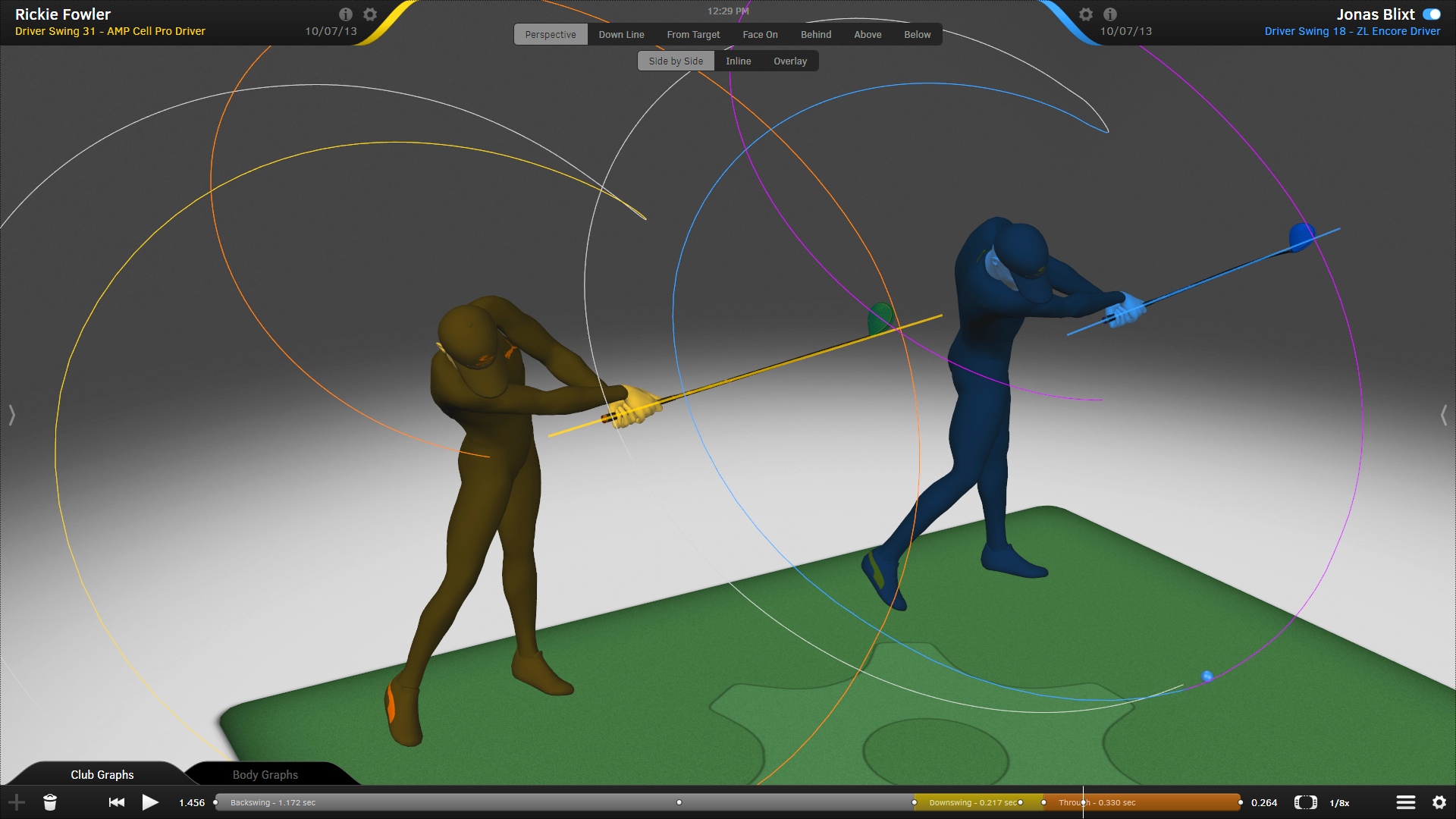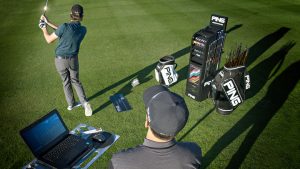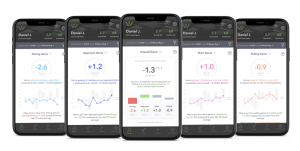Opinion & Analysis
The future of club fitting is going virtual

Thanks to technology, you can buy everything from custom-made suits to orthotics online without ever walking into a store or working in person with an expert.
Now, with the help of video and launch monitors, along with a deeper understanding of dynamics than ever before, club fitting is quickly going virtual too, and it’s helping golfers find better equipment faster!
What really took so long?

The real advancements started in the coaching world around a decade ago. What used to require heavy cameras and tripods now simply requires a phone and you have a high-definition slow-motion video that can be sent around the world in a matter of seconds.

Beyond video, modern launch monitors and their ability to capture data have quickly turned a guessing game of “maybe this will work” into a precision step-by-step process of elimination to optimize. When you combine video and launch monitor elements with an understanding of club fitting principles and basic biomechanics, you have the ability to quickly evaluate a golfer’s equipment and make recommendations to help them play better golf.
The benefits of virtual fitting
- Any golfer with a phone and access to a launch monitor can get high-level recommendations from a qualified fitter.
- Time and cost-saving to and from a fitter. (This seems obvious, but one of the reasons I personally receive so many questions about club fitting is because those reaching out don’t have access to fitting facilities within a reasonable drive)
- It’s an opportunity to get a better understanding our your equipment from an expert.
How virtual fittings really work
The key element of a virtual fitting is the deep understanding of the available products to the consumer. On an OEM level, line segmentation makes this fairly straightforward, but it becomes slightly more difficult for brand-agnostic fitters that have so many brands to work with, but it also shows their depth of knowledge and experience.
It’s from this depth of knowledge and through an interview that a fitter can help analyze strengths and weaknesses in a player’s game and use their current clubs as a starting point for building a new set—then the video and launch monitor data comes in.
But it can quickly go very high level…
One of the fastest emerging advancements in this whole process is personalized round tracking data from companies like Arccos, which gives golfers the ability to look at their data without personal bias. This allows the golfer along with any member of their “team” to get an honest assessment of where improvements can be found. The reason this is so helpful is that golfers of all skill levels often have a difficult time being critical about their own games or don’t even really understand where they are losing shots.

It’s like having a club-fitter or coach follow you around for 10 rounds of golf or more—what was once only something available to the super-elite is now sitting in your pocket. All of this comes together and boom, you have recommendations for your new clubs.
Current limitations
We can’t talk about all the benefits without pointing out some of the potential limitations of virtual club fittings, the biggest being the human element that is almost impossible to replicate by phone or through video chat.
The other key factor is how a player interprets feel, and when speaking with an experienced fitter recently while conducting a “trial fitting” the biggest discussion point was how to communicate with golfers about what they feel in their current clubs. Video and data can help draw some quick conclusions but what a player perceives is still important and this is where the conversation and interview process is vital.
Who is offering virtual club fittings?
There are a lot of companies offering virtual fittings or fitting consultations over the phone. One of the biggest programs is from Ping and their Tele-Fitting process, but other companies like TaylorMade and PXG also have this service available to golfers looking for new equipment.
Smaller direct-to-consumer brands like New level, Sub 70, and Haywood Golf have offered these services since their inception as a way to work with consumers who had limited experience with their products but wanted to opportunity to get the most out of their gear and their growth has proven this model to work.
- LIKE32
- LEGIT6
- WOW2
- LOL2
- IDHT0
- FLOP6
- OB6
- SHANK60
19th Hole
Vincenzi’s 2024 Zurich Classic of New Orleans betting preview

The PGA TOUR heads to New Orleans to play the 2023 Zurich Classic of New Orleans. In a welcome change from the usual stroke play, the Zurich Classic is a team event. On Thursday and Saturday, the teams play best ball, and on Friday and Sunday the teams play alternate shot.
TPC Louisiana is a par 72 that measures 7,425 yards. The course features some short par 4s and plenty of water and bunkers, which makes for a lot of exciting risk/reward scenarios for competitors. Pete Dye designed the course in 2004 specifically for the Zurich Classic, although the event didn’t make its debut until 2007 because of Hurricane Katrina.
Coming off of the Masters and a signature event in consecutive weeks, the field this week is a step down, and understandably so. Many of the world’s top players will be using this time to rest after a busy stretch.
However, there are some interesting teams this season with some stars making surprise appearances in the team event. Some notable teams include Patrick Cantlay and Xander Schauffele, Rory McIlroy and Shane Lowry, Collin Morikawa and Kurt Kitayama, Will Zalatoris and Sahith Theegala as well as a few Canadian teams, Nick Taylor and Adam Hadwin and Taylor Pendrith and Corey Conners.
Past Winners at TPC Louisiana
- 2023: Riley/Hardy (-30)
- 2022: Cantlay/Schauffele (-29)
- 2021: Leishman/Smith (-20)
- 2019: Palmer/Rahm (-26)
- 2018: Horschel/Piercy (-22)
- 2017: Blixt/Smith (-27)
2024 Zurich Classic of New Orleans Picks
Tom Hoge/Maverick McNealy +2500 (DraftKings)
Tom Hoge is coming off of a solid T18 finish at the RBC Heritage and finished T13 at last year’s Zurich Classic alongside Harris English.
This season, Hoge is having one of his best years on Tour in terms of Strokes Gained: Approach. In his last 24 rounds, the only player to top him on the category is Scottie Scheffler. Hoge has been solid on Pete Dye designs, ranking 28th in the field over his past 36 rounds.
McNealy is also having a solid season. He’s finished T6 at the Waste Management Phoenix Open and T9 at the PLAYERS Championship. He recently started working with world renowned swing coach, Butch Harmon, and its seemingly paid dividends in 2024.
Keith Mitchell/Joel Dahmen +4000 (DraftKings)
Keith Mitchell is having a fantastic season, finishing in the top-20 of five of his past seven starts on Tour. Most recently, Mitchell finished T14 at the Valero Texas Open and gained a whopping 6.0 strokes off the tee. He finished 6th at last year’s Zurich Classic.
Joel Dahmen is having a resurgent year and has been dialed in with his irons. He also has a T11 finish at the PLAYERS Championship at TPC Sawgrass which is another Pete Dye track. With Mitchell’s length and Dahmen’s ability to put it close with his short irons, the Mitchell/Dahmen combination will be dangerous this week.
Taylor Moore/Matt NeSmith +6500 (DraftKings)
Taylor Moore has quickly developed into one of the more consistent players on Tour. He’s finished in the top-20 in three of his past four starts, including a very impressive showing at The Masters, finishing T20. He’s also finished T4 at this event in consecutive seasons alongside Matt NeSmith.
NeSmith isn’t having a great 2024, but has seemed to elevate his game in this format. He finished T26 at Pete Dye’s TPC Sawgrass, which gives the 30-year-old something to build off of. NeSmith is also a great putter on Bermudagrass, which could help elevate Moore’s ball striking prowess.
- LIKE4
- LEGIT1
- WOW1
- LOL0
- IDHT0
- FLOP2
- OB1
- SHANK1
19th Hole
Vincenzi’s 2024 LIV Adelaide betting preview: Cam Smith ready for big week down under

After having four of the top twelve players on the leaderboard at The Masters, LIV Golf is set for their fifth event of the season: LIV Adelaide.
For both LIV fans and golf fans in Australia, LIV Adelaide is one of the most anticipated events of the year. With 35,000 people expected to attend each day of the tournament, the Grange Golf Club will be crawling with fans who are passionate about the sport of golf. The 12th hole, better known as “the watering hole”, is sure to have the rowdiest of the fans cheering after a long day of drinking some Leishman Lager.
The Grange Golf Club is a par-72 that measures 6,946 yards. The course features minimal resistance, as golfers went extremely low last season. In 2023, Talor Gooch shot consecutive rounds of 62 on Thursday and Friday, giving himself a gigantic cushion heading into championship Sunday. Things got tight for a while, but in the end, the Oklahoma State product was able to hold off The Crushers’ Anirban Lahiri for a three-shot victory.
The Four Aces won the team competition with the Range Goats finishing second.
*All Images Courtesy of LIV Golf*
Past Winners at LIV Adelaide
- 2023: Talor Gooch (-19)
Stat Leaders Through LIV Miami
Green in Regulation
- Richard Bland
- Jon Rahm
- Paul Casey
Fairways Hit
- Abraham Ancer
- Graeme McDowell
- Henrik Stenson
Driving Distance
- Bryson DeChambeau
- Joaquin Niemann
- Dean Burmester
Putting
- Cameron Smith
- Louis Oosthuizen
- Matt Jones
2024 LIV Adelaide Picks
Cameron Smith +1400 (DraftKings)
When I pulled up the odds for LIV Adelaide, I was more than a little surprised to see multiple golfers listed ahead of Cameron Smith on the betting board. A few starts ago, Cam finished runner-up at LIV Hong Kong, which is a golf course that absolutely suits his eye. Augusta National in another course that Smith could roll out of bed and finish in the top-ten at, and he did so two weeks ago at The Masters, finishing T6.
At Augusta, he gained strokes on the field on approach, off the tee (slightly), and of course, around the green and putting. Smith able to get in the mix at a major championship despite coming into the week feeling under the weather tells me that his game is once again rounding into form.
The Grange Golf Club is another course that undoubtedly suits the Australian. Smith is obviously incredibly comfortable playing in front of the Aussie faithful and has won three Australian PGA Championship’s. The course is very short and will allow Smith to play conservative off the tee, mitigating his most glaring weakness. With birdies available all over the golf course, there’s a chance the event turns into a putting contest, and there’s no one on the planet I’d rather have in one of those than Cam Smith.

Louis Oosthuizen +2200 (DraftKings)
Louis Oosthuizen has simply been one of the best players on LIV in the 2024 seas0n. The South African has finished in the top-10 on the LIV leaderboard in three of his five starts, with his best coming in Jeddah, where he finished T2. Perhaps more impressively, Oosthuizen finished T7 at LIV Miami, which took place at Doral’s “Blue Monster”, an absolutely massive golf course. Given that Louis is on the shorter side in terms of distance off the tee, his ability to play well in Miami shows how dialed he is with the irons this season.
In addition to the LIV finishes, Oosthuizen won back-to-back starts on the DP World Tour in December at the Alfred Dunhill Championship and the Mauritus Open. He also finished runner-up at the end of February in the International Series Oman. The 41-year-old has been one of the most consistent performers of 2024, regardless of tour.
For the season, Louis ranks 4th on LIV in birdies made, T9 in fairways hit and first in putting. He ranks 32nd in driving distance, but that won’t be an issue at this short course. Last season, he finished T11 at the event, but was in decent position going into the final round but fell back after shooting 70 while the rest of the field went low. This season, Oosthuizen comes into the event in peak form, and the course should be a perfect fit for his smooth swing and hot putter this week.

- LIKE7
- LEGIT1
- WOW0
- LOL0
- IDHT0
- FLOP0
- OB0
- SHANK0
Opinion & Analysis
The Wedge Guy: What really makes a wedge work? Part 1

Of all the clubs in our bags, wedges are almost always the simplest in construction and, therefore, the easiest to analyze what might make one work differently from another if you know what to look for.
Wedges are a lot less mysterious than drivers, of course, as the major brands are working with a lot of “pixie dust” inside these modern marvels. That’s carrying over more to irons now, with so many new models featuring internal multi-material technologies, and almost all of them having a “badge” or insert in the back to allow more complex graphics while hiding the actual distribution of mass.
But when it comes to wedges, most on the market today are still single pieces of molded steel, either cast or forged into that shape. So, if you look closely at where the mass is distributed, it’s pretty clear how that wedge is going to perform.
To start, because of their wider soles, the majority of the mass of almost any wedge is along the bottom third of the clubhead. So, the best wedge shots are always those hit between the 2nd and 5th grooves so that more mass is directly behind that impact. Elite tour professionals practice incessantly to learn to do that consistently, wearing out a spot about the size of a penny right there. If impact moves higher than that, the face is dramatically thinner, so smash factor is compromised significantly, which reduces the overall distance the ball will fly.
Every one of us, tour players included, knows that maddening shot that we feel a bit high on the face and it doesn’t go anywhere, it’s not your fault.
If your wedges show a wear pattern the size of a silver dollar, and centered above the 3rd or 4th groove, you are not getting anywhere near the same performance from shot to shot. Robot testing proves impact even two to three grooves higher in the face can cause distance loss of up to 35 to 55 feet with modern ‘tour design’ wedges.
In addition, as impact moves above the center of mass, the golf club principle of gear effect causes the ball to fly higher with less spin. Think of modern drivers for a minute. The “holy grail” of driving is high launch and low spin, and the driver engineers are pulling out all stops to get the mass as low in the clubhead as possible to optimize this combination.
Where is all the mass in your wedges? Low. So, disregarding the higher lofts, wedges “want” to launch the ball high with low spin – exactly the opposite of what good wedge play requires penetrating ball flight with high spin.
While almost all major brand wedges have begun putting a tiny bit more thickness in the top portion of the clubhead, conventional and modern ‘tour design’ wedges perform pretty much like they always have. Elite players learn to hit those crisp, spinny penetrating wedge shots by spending lots of practice time learning to consistently make contact low in the face.
So, what about grooves and face texture?
Grooves on any club can only do so much, and no one has any material advantage here. The USGA tightly defines what we manufacturers can do with grooves and face texture, and modern manufacturing techniques allow all of us to push those limits ever closer. And we all do. End of story.
Then there’s the topic of bounce and grinds, the most complex and confusing part of the wedge formula. Many top brands offer a complex array of sole configurations, all of them admittedly specialized to a particular kind of lie or turf conditions, and/or a particular divot pattern.
But if you don’t play the same turf all the time, and make the same size divot on every swing, how would you ever figure this out?
The only way is to take any wedge you are considering and play it a few rounds, hitting all the shots you face and observing the results. There’s simply no other way.
So, hopefully this will inspire a lively conversation in our comments section, and I’ll chime in to answer any questions you might have.
And next week, I’ll dive into the rest of the wedge formula. Yes, shafts, grips and specifications are essential, too.
- LIKE30
- LEGIT7
- WOW1
- LOL1
- IDHT2
- FLOP3
- OB1
- SHANK3
-

 19th Hole2 weeks ago
19th Hole2 weeks agoDave Portnoy places monstrous outright bet for the 2024 Masters
-

 19th Hole2 weeks ago
19th Hole2 weeks agoTiger Woods arrives at 2024 Masters equipped with a putter that may surprise you
-

 19th Hole3 weeks ago
19th Hole3 weeks agoReport: Tiger Woods has ‘eliminated sex’ in preparation for the 2024 Masters
-

 19th Hole7 hours ago
19th Hole7 hours ago‘Absolutely crazy’ – Major champ lays into Patrick Cantlay over his decision on final hole of RBC Heritage
-

 19th Hole1 week ago
19th Hole1 week agoTwo star names reportedly blanked Jon Rahm all week at the Masters
-

 19th Hole6 days ago
19th Hole6 days agoReport: LIV Golf identifies latest star name they hope to sign to breakaway tour
-

 19th Hole1 week ago
19th Hole1 week agoNeal Shipley presser ends in awkward fashion after reporter claims Tiger handed him note on 8th fairway
-

 19th Hole5 days ago
19th Hole5 days agoBrandel Chamblee has ‘no doubt’ who started the McIlroy/LIV rumor and why















Sean Foster-Nolan
Mar 2, 2021 at 7:08 am
Call me a traditionalist, but I like the hands on feeling of a fitting, trying different head/shaft combinations, as well as watching the ball flight.
Roy Nix
Mar 1, 2021 at 1:20 pm
Nice article. I have been offering online fittings for some time now and it’s working for my customers. I had to close my bricks & mortar shop a few years ago, but after nearly 20 years of fitting with a Flightscope and tracking golfer’s characteristics to specific shaft types and head designs it works online. I require videos and lots of email back an forth (so I have an audit trail) I can zero in on all aspects of what my golfer needs and build it for them.
dj
Feb 27, 2021 at 7:47 am
Quote: Any golfer with a phone and access to a launch monitor can get high-level recommendations from a qualified fitter.
Most golfers don’t have access to a launch monitor or if they do, it’s at a golf shop that does club fittings.
amgpuma
Feb 26, 2021 at 8:29 pm
sounds like medical consultation by phone during this distopian times. Sorry, no you cannot be fitted by sending figures from a launch monitor to a clubfitter. You need to try several shafts and heads then adjust loft, lie, swing weight etc etc etc. Does the club fitter gonna do it by telepahy or they gonna spent a fortune in shipping?Sorry dont see the point. Virtual checking of your figures achieved with your existing set is anything but custom fitting
SV
Feb 26, 2021 at 10:55 am
What I don’t understand with a virtual fitting is how does the person being fit obtain different product to try? If everything is based on your clubs, video and launch monitor data, how does the fitter know what will be “the One” for you? There could be several that meet the need.
Let me say, based on in person fittings, I am skeptical. As an example, I have been consistently told my irons should be 2* flat. In reality, on the golf course when I use 2* flat irons the heel catches and I hit a big hook. Bend them to 3* flat and they work fine.
Holden Tudiks
Feb 26, 2021 at 12:22 pm
Because we don’t play golf on range mats in a booth. Club fitting is a grift.
Carolyn
Feb 26, 2021 at 1:32 pm
Agree and there are no houses or fear of hazards when hitting indoors on a mat. Think about how well you hit that warm up bucked off a mat before your round only to hit your first drive out of bounds or 25 yards down the middle?? Also the article fails to mention once you get you numbers how long it is going to take for the club company to deliver your clubs…right now if you look around the web you will find club companies are anywhere from 3 weeks to months before your “Customized” club will be delivered…
amgpuma
Feb 26, 2021 at 8:23 pm
guess you havent been fitted properly, a grift is what major oem do by selling their clubs